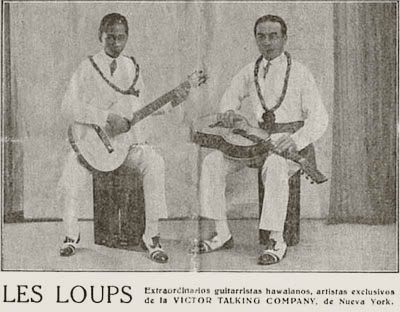Gastão Bueno Lobo
The man who introduced the banjo to Brazil.
by Jorge Mello
18 July 2007
Os Lobos, aka Les Loups: Oscar Alemán (left) and Gastão Bueno LoboGastão Bueno Lobo was born in 1891 in the city of Campos, Rio de Janeiro. Of his family and musical education we know nothing. We also have no notion of how long he lived in Campos and which schools he attended. The author of this article has managed to obtain a copy of Bueno Lobo’s death certificate after much exertion. Unfortunately, the certificate has not added in any way to the existing body of knowledge about the musician.
The first reference to Bueno Lobo was given by Pixinguinha, when he declared that Bueno Lobo was the person who, in the late 1910s, introduced the banjo to Brazil. It’s likely that the same trip from which he brought the banjo also yielded the Hawaiian guitar, an instrument that he learned to play quite easily (since he played guitar to perfection) from Hawaiian natives.
The second reference is owing to the rediscovery of the Argentine guitarist Oscar Alemán. Thanks to the interest in his life and work, we learned that Bueno Lobo was his “musical father,” teaching him to play guitar, cavaquinho, and Hawaiian guitar, presumably in 1924. The following year, as the duo Os Lobos (an allusion to Gastão’s surname), they traveled to Rio de Janeiro. In the capital they joined the comic Pablo Palitos and toured through Brazil’s northeast before proceeding to Buenos Aires, Argentina, where they appeared in some of the most important venues.
Next, Os Lobos (now Los Lobos) recorded twelve 78-rpm discs for the Victor label, including six tunes composed by Bueno Lobo. In some of these recordings, the duo was accompanied by the violinist Elviro Vardaro. The contract with Victor was signed at the end of 1927 and extended until the beginning of 1929, when the duo left to tour Europe under contract to Harry Fleming. We won’t linger over the details of this phase, since it’s been very well told in Oscar Alemán’s biographies (see Keep Swinging). Upon arrival in Europe, Los Lobos appeared in the principal cities of Spain before continuing to Greece, Italy, Germany, Belgium, Holland, and Portugal.
Bueno Lobo and Oscar continued performing together until 1931. A great deal of speculation exists regarding their breakup. The fact is that from May to September of 1932, Bueno Lobo was already performing at Sociedade Rádio Philips do Brasil. Beginning in October of that year, he transferred to Rádio Mayrink Veiga. Also in 1932, he participated as performer, accompanist, or composer in four records released by Odeon. Five tunes on those records were of his authorship.
In 1933, he appeared as an individual performer alongside musicians such as Custódio Mesquita, Tute, Luperce Miranda, and others. The following year saw the birth of the Original Orchestra under the direction of Gastão Bueno Lobo. In 1935, the following orchestras performed on Rádio Mayrink Veiga: Orchestra Symphonica of Muraro; Orchestra de Danças of Napoleão Tavares; Orchestra Regional Brasileira of maestro Vivas; and Original Orchestra of Gastão Bueno Lobo.
The year 1936 saw the birth of the incredibly successful Conjuncto Hawaiano of Rádio PRA-9 (Mayrink Veiga), whose members were Gastão Bueno Lobo, Garoto, Aymoré, and Laurindo Almeida. A year later, Bueno Lobo made duo appearances—at times with Aymoré, at others with Laurindo Almeida, with the latter playing Hawaiian guitar and Bueno Lobo playing guitar. Also in 1937, Bueno Lobo conducted the Orchestra de Concertos of the same radio station, with Laurindo Almeida as soloist on many occasions.
In 1938, Bueno Lobo participated in an Odeon recording of two tunes composed by Laurindo Almeida. In one he was the main interpreter, in the other an accompanist with Tute. During this year, he performed as an individual artist at Rádio Mayrink Veiga, but his name appeared less and less frequently in the programs.
On 3 June 1939, came the notice of his death by ingestion of hydrochloric acid.
This is how, at the age of 48, died the musician who introduced the banjo and the Hawaiian guitar to Brazil.
The waltz “Se Recordar É Viver” (If Remembering Is Living) by Gastão Bueno Lobo and Laurindo Almeida, first recorded on 10 August 1939 by Roberto Paiva and released on Odeon 11848-A in May 1940, was discovered in one of the jacket pockets that Gastão was wearing when he was found dead. Despite its ironic title, the recording was a tribute to this great musician.
Translated from the Portuguese by Daniella Thompson.
Copyright © 2007–2013 Jorge Mello & Daniella Thompson. All rights reserved.


